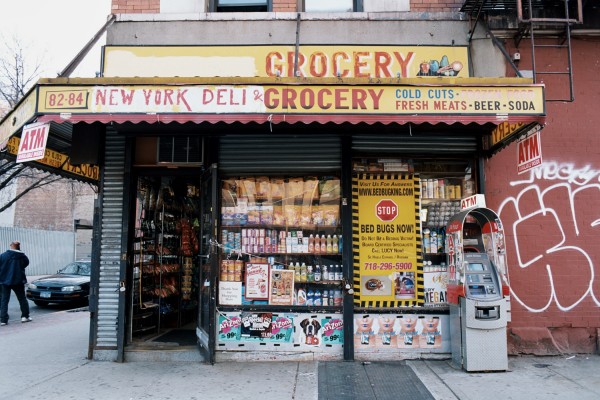 New York Yimby reports that Technology and urbanity have a long and tempestuous relationship, with the former’s advancement over the past century having had an occasionally deleterious effect on the latter.This has been most evident when periods of previously unimaginable progress have yielded inventions like the automobile, which in turn led to the temporary collapse of many inner cities. Now, as online retail continues to outpace brick and mortar shopping, technology has once again laid siege to the fabric of New York City, threatening the time-honored local bodega, and potentially undermining a segment of local retail that has value far beyond its shelves.
New York Yimby reports that Technology and urbanity have a long and tempestuous relationship, with the former’s advancement over the past century having had an occasionally deleterious effect on the latter.This has been most evident when periods of previously unimaginable progress have yielded inventions like the automobile, which in turn led to the temporary collapse of many inner cities. Now, as online retail continues to outpace brick and mortar shopping, technology has once again laid siege to the fabric of New York City, threatening the time-honored local bodega, and potentially undermining a segment of local retail that has value far beyond its shelves.
While Jane Jacobs had many terrible ideas, some of which have resulted in places like the West Village evolving into the equivalent of an Onion Article, one of her most valuable and substantial contributions was advocacy of the importance of “eyes on the street,” a function of a healthy neighborhood retail scene. With storefronts and their occupants keeping vigilant over an area, criminal activity is deterred, while the pedestrian experience is substantially improved. The concept is not difficult to understand.
In this regard, the local bodega is perhaps one of the most valuable assets New York City real estate has to offer. Besides the aspect of convenience that the neighborhood stores provide, many are also open 24 hours a day (or close to it), providing a spot for local characters to congregate alongside store owners and shop workers. The sum of this activity plays an immeasurable role in ensuring that peripheral neighborhoods generally lacking in retail still have spots that light up the nighttime streets, and eyes to watch them.
Here, it is important to make a distinction between the criticism of a specific idea and attacks on the technology sector in general, which are counter-productive and only serve to create animosity on both sides. The problem with automating bodegas has nothing to do with the actual vending machine-esque service in and of itself, which — made obvious by its description — is a simple re-hashing of an existing idea. The issue lies in the unquantifiable gap in quality of living that is likely to result if bodegas do begin to close en-masse.
Providing cheaper access to goods is certainly a noble idea, but when many peripheral neighborhoods depend on bodegas for both basic needs, and public safety, their benefits become substantially more obvious. The amount of taxpayer dollars saved by the NYPD thanks to bodegas is likely immeasurable, and in turn, this also improves the value of real estate in surrounding blocks. Though exact numbers are impossible to quantify, the social value of these specific mom & pop retail stores is vastly greater than the material goods within.
While it is impossible to forcibly legislate which businesses ultimately occupy retail storefronts, the arguments over the future of the bodega show that the reaction to a poorly-conceived start-up idea largely misses some of the reasons they may have a chance at success, and these are largely the fault of zoning. Most importantly, it is actually impossible to build new retail space at all along most streets in many of New York City’s most famous neighborhoods, ranging from St. Marks to the Upper West Side, and when critics complain of food deserts, it is usually City Hall that should be blamed.
New York City will always continue to change, adapt, and hopefully, grow. But going about this growth in the right manner is what has typically separated New York from its less-successful counterparts across the rest of the continent (i.e., every single other city), which is probably why “Brodega” is doomed from the start.
New Yorkers may not know the ins and outs of why retail can no longer be built on the vast majority of side-streets in the city, but partially thanks to Jane Jacobs, they do understand the value of eyes on the street, and the importance of local spaces for socializing, both of which are crucial and immensely beneficial niches that bodegas fill. Instead of focusing on why “Brodega” is a terrible idea, there needs to be comprehensive reform of where retail can and cannot be built, or the likelihood that bodegas and the rest of the five boroughs’ mom & pop retail scene go the way of the dinosaurs is going to increase substantially.
Related articles
- From Harlem To Hollis Prepare For Coastal Storm Risks (harlemworldmag.com)
- Health Department Reports Four Babies Born With Zika Virus In New York City (harlemworldmag.com)
- New York City Experiences Safest First Quarter From Harlem To Hollis (harlemworldmag.com)
Become a Harlem Insider!
By submitting this form, you are consenting to receive marketing emails from: . You can revoke your consent to receive emails at any time by using the SafeUnsubscribe® link, found at the bottom of every email. Emails are serviced by Constant Contact








